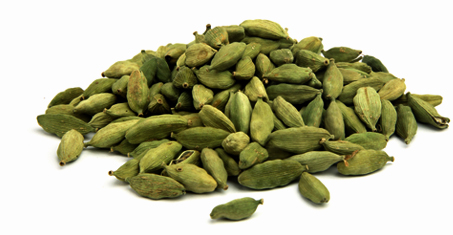What Is Small Green Cardamom?
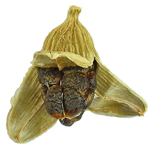
In India Cardamom is known as the "Queen of spices" to black pepper's titled as the "King of spices". The sweetly aromatic cardamom is the fruit of a tropical plant, and is one of the world's most expensive spices, after saffron and vanilla. There are three grades in which Indian cardamom is well known in the International market, AGEB - Alleppey Green Extra Bold Cardamom, AGB - Alleppey Green Bold Cardamom and AGS - Alleppey Green Superior Cardamom. Indian cardamom is known worldwide for its quality and is exported to various countries.
Plant and Cultivation of Small Green Cardamom
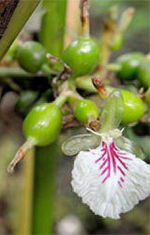
The Cardamom Plant is a tropical plant that is typically grown in places like India, Vietnam and Guatemala. The plant will only flower and fruit in tropical climates. Green cardamom pods come from a perennial bush of the ginger family that Leafy shoots arise 1.5 to 6 metres (5 to 20 feet) from the branching rootstock. Flowering shoots, approximately 1 metre long, may be upright or sprawling; each bears numerous flowers about 5 cm (2 inches) in diameter with greenish petals and a purple-veined white lip. Growing cardamom is extremely labor intensive. The tall plants, grown on plantations in India or Guatemala, flower for eight or nine months of the year. Each pod, or capsule, ripens slowly, and must be plucked when it is three-quarters ripe. After harvest, the pods are washed and dried.
Description of Small Green Cardamom
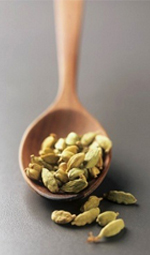
Cardamom has a strong, unique taste, with an intensely aromatic fragrance. Cardamom is best stored in pod form, because once the seeds are exposed or ground, they quickly lose their flavour.It is the dried, un ripened fruit of the plant. The small, brown-black sticky seeds are contained in a pod in three double rows with about six seeds in each row. The fruit capsules, green in colour, which are collected just before maturity, are three-sided, 8 - 25 mm long and 2 - 4 mm wide and have three compartments containing a total of 15 - 20 seeds (2 - 4 mm in diameter). The seeds are found in oval shaped, roughly triangular fruit pods that are between 1/4 and 1 inch long. Their dried surface is rough and furrowed, the large ‘blacks’ having deep wrinkles. The texture of the pod is that of tough paper. Pods are available whole or split and the seeds are sold loose or ground.
Uses of Small Green Cardamom
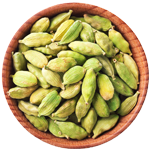
Specific uses of green cardamom vary with different cuisines and cultures. Cardamom is a key ingredient in sweet baked goods in Scandanavia, like holiday Julekake and Finnish pulla. In the Arab world, ground green cardamom is used in strong brewed coffee and in rice pilaf. In India, green cardamom features prominently in all kinds of curries, spice mixes, sweet treats and Masala chai spiced tea. Amusingly, green cardamom is also an ingredient in Wrigley's Eclipse Breeze Exotic Mint chewing gum.
10 Health Benefits of Small Green Cardamom
1-Detoxification – Cardamoms are known to detoxify the body. They are rich in minerals and vitamins like Vitamin A, B, C, niacin, riboflavin etc. It is a great blood purifier and removes excess urea, calcium and other toxins from the kidney. This is specially a home remedy used post delivery
2-Antioxidants – Many of the phytonutrients, vitamins and essential oils which are present in cardamom act as antioxidants. This magical spice helps in cleaning up the free radicals and tends to resist cellular aging.
3-Depression – Though the real science behind the anti-depressant qualities of this spice has not been studied yet, Ayurvedic practitioners firmly believe that the cardamom tea is a perfect way to fight depression. It has a natural ingredient which tends to detoxify the body and rejuvenate the cells which altogether help in fighting depression.
4-Cold and Flu – Cardamom is a pungent spice which tends to help in preventing and relieving cold and flu symptoms. Cardamom is a good home remedy for cold and flu. Just make cardamom tea, consume and your headache and cold will be gone in a jiffy.
5-Bad breath/Oral Health – Cardamom is a cure for bad breath. Apart from its trait that helps in curing bad breath, cardamom is also used for mouth ulcers and mouth infections. Chew a couple of cardamom seeds and it solves your breath problem (halitosis)
6-Alleviates Digestive Issues – Cardamom seeds are the best solution for indigestion, belching and flatulence problems. Cardamom helps improve your digestion of food.
7-Improves Blood Circulation – Cardamom contains vitamin C which is a powerful antioxidant. It improves blood circulation throughout the body, thus improving skin complexion as well.
8-Imparts Fragrance – Cardamom is often used in cosmetics to impart fragrance. Due to their distinct spicy, sweet scent, both cardamom and cardamom oil are used in perfumes, soaps, body wash, powders and other cosmetics. Oriental style perfumes and other scented products often use cardamom as an ingredient in addition to other essential oils.
9-Clear Skin – Black cardamoms help in flushing out the toxins, free radicals and dangerous fluids those are harmful to the body including your skin. Therefore, chewing on some black cardamom detoxifies your body, thus providing you with a clearer skin.
10-Hair Health – Cardamom helps in strengthening the roots, thereby helping you gain strong hair. It is also known to provide shine and lustre to your hair.
Producing Countries of Cardamom
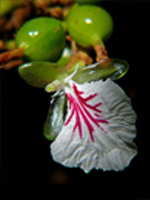
Cardamom is generally produced in the tropical regions of the world. Major producing countries of cardamom in the world are Guatemala, India, Srilanka, Iran, Tanzania etc.
Guatemala had become the largest producer of cardamom in the world, with an average annual yield between 30,000 to 35,000.
India, formerly the largest producer, has been the second worldwide largest producer, generating around 15,000 tonnes annually.
Consuming Countries of Cardamom

Consumption of cardamom has sharply increased throughout the world during the last two decades. The major consuming countries of cardamom are the Middle Eastern countries, India, Pakistan, European countries, the US, and Japan.
Middle Eastern countries such as Saudi Arabia and the United Arab Emirates, and South-East Asian countries such as India, etc.
60% of the world production is exported to Arab (South West Asia, North Africa) countries, where the larger part is used to prepare coffee.
Saudi Arabia is the single largest importer of Cardamom in the world, followed by Kuwait.
Recipe for Beverages with Cardamom
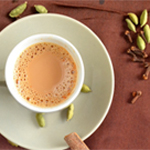
Cardamom Tea
IngredientsA: 3 Green Cardamom Pods
B: 2 Brown Cardamom Pods
C: 2 Teabags
D: 4 Tbsp Sugar
E: Milk to Taste
A: Put about seven cups of fresh cold water in a large saucepan.
B: Lightly smash the cardamoms in a pestle and mortar. Add to the water.
C: Bring to the boil.
D: When boiling, add the teabags and sugar.
E: Add enough milk to turn it a pale beige colour.
F:Bring to the boil again and just as it is rising to the top of the pan, switch off the heat.
G: Pour through a strainer.
Recipe for Cooking With Cardamom
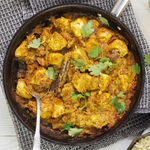
Cardamom Butter Chicken
IngredientsA: 2 Garlic Cloves, Roughly Chopped, Thumb-Sized Piece Ginger, Chopped
B: 2 Green Chillies, Chopped (leave seeds in if you like it hot)
C: 3 Tbsp Ghee, or Vegetable Oil, 2 Onions, Sliced
D: 2 Tbsp Each Turmeric, Garam Masala and Ground Cumin
E: 4 Chicken Breasts, Cut Into 2½ cm Cubes, 4 Cloves, 12 Cardamom Pods
A: Place the garlic, ginger, chillies and coriander stalks in the small bowl of a food processor with a good pinch of salt, and blend to a fine paste – or grind to a paste using a pestle and mortar.
B: Heat 2 tbsp of the ghee or oil in a large pan, add the onions and cook slowly for 15-20 mins until golden and caramelised. Tip in the garlic-ginger paste, turn up the heat and cook for a further 5 mins. Add the ground spices and cook for 2 mins more until fragrant. Scoop the spicy onion mixture out of the pan into a bowl.
C: Add the remaining ghee or oil to the pan and cook the chicken over a medium-high heat until browned all over. Tip into a bowl, cover and set aside.
D: Return the onion mixture to the pan along with the whole spices, tomatoes and a can full of water (400ml). Bring to the boil, then cover and simmer gently for 40 mins.
E: Return the chicken to the pan and cook, uncovered, for a further 10 mins until the sauce has thickened and the chicken is cooked through. Stir in the yogurt and cream, season well and scatter with coriander leaves. Serve with chapatis and rice.
Recipe for Dessert With Cardamom
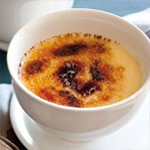
Cardamom Cream Brulees
IngredientsA: 2 Cups Heavy Cream
B: 1 Vanilla Bean, Split Lengthwise
C: 2 Pods Green Cardamom, Cracked Open
D: 6 Egg Yolks
E: 10 Tbs. Superfine (caster) Sugar
A: Preheat an oven to 325°F. Select a baking dish 2 to 2 1/2 inches deep and large enough to hold four 3/4-cup ramekins or other ovenproof dishes. Line the baking dish with a thin kitchen towel.
B: In a saucepan over medium heat, combine the cream, vanilla bean, and cardamom pods and their seeds. Bring to a simmer and cook for 1 minute. Remove the vanilla bean and, using the tip of a knife, scrape the seeds into the cream. Continue to simmer the cream, stirring often, for 3 to 4 minutes more. Remove from the heat and let cool slightly.
C: In a bowl, whisk together the egg yolks, 6 Tbs. of the sugar and the salt until thickened, about 2 minutes. Slowly add the warm (not hot) cream mixture, whisking constantly. Pour the custard through a fine-mesh sieve into a 2-cup measuring pitcher. Skim any bubbles off the surface. Divide the custard evenly among the prepared ramekins. Place the ramekins in the towel-lined dish and pour hot water into the dish to reach halfway up the sides of the ramekins. Cover the dish loosely with aluminum foil.
D: Bake the custards until they are set but jiggle slightly in the center when shaken, 20 to 25 minutes. Transfer the baking dish to a wire rack and let the custards cool slightly, then lift the ramekins out of the water bath and set on the rack to cool for 1 hour. Cover tightly and refrigerate for at least 3 hours or up to overnight.
E: Just before serving, preheat a broiler. Sprinkle each custard evenly with 1 Tbs. of the remaining sugar. Place the custards on a rimmed baking sheet and slide under the broiler about 4 inches from the heat source. Broil just until the sugar caramelizes, 1 to 2 minutes. Alternatively, use a kitchen torch to caramelize the sugar. Serve immediately.

